
|
Today's Calendar |
| | Simply Economics |
| | International Perspective |
| | Resource Center |
 |
|
| 1999 Articles |
|
By Evelina M. Tainer, Chief Economist Econoday Fed tightens, market rallies. Go figure...
Alan speaks; equities fall All bets were off on Friday. Alan Greenspan discussed new challenges for monetary policy at the annual bankers' conference in Jackson Hole, Wyoming (sponsored by the Kansas City Federal Reserve Bank). He made a couple of valid points about profits being overestimated because of accounting problems. He talked about risk aversion and consumer confidence. This was tame stuff. The kicker came in later in the morning when the IMF's chief economist told Greenspan Company that they should regulate the stock market. Greenspan's response was that the Fed would certainly provide liquidity in a market crash, but was not likely to regulate the stock market when stock prices were rising. It would appear a bullish remark for market players. Instead, the bears translated this to mean that the Fed will consider stock market movements in their policy-making (as if they didn't before.) 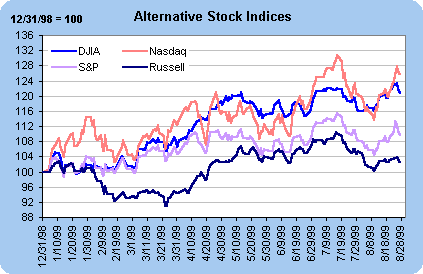 Stock prices fell on Friday. All major market indices but the NASDAQ composite were down from Tuesday's close (day of the rate hike). The S&P 500 and the NASDAQ composite are still higher than a week ago - even after today's drop. One of the problems noted by market commentators is the relatively low volume. Thin markets exacerbate movements made after indicators or Greenspan comments. The same problem will be evident next week in advance of the Labor Day holiday.
Fixed income markets like Fed rate hike, but not Alan's conference comments 
Consumer spending still outpaces income Personal consumption expenditures increased 0.4 percent in July, showing a slight moderation in the past two months, compared with the previous three months. Perhaps consumers are thinking about closing the gap between income and outlays growth. As indicated in the chart below, consumers are spending much more than they are earning - a trend that began in 1997. The personal saving rate continues to decrease and remains mired in negative territory. 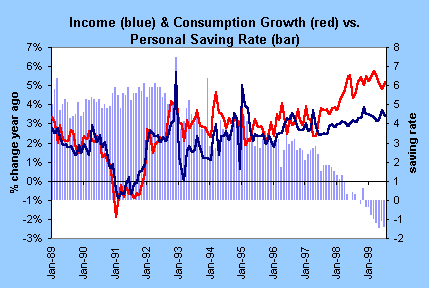 The bottom line on personal income and outlays? Consumers don't feel the need to add to their savings accounts when economic activity is robust and the stock market is booming. The negative savings rate reflects a high degree of confidence. (Incidentally, the University of Michigan's consumer sentiment index - reported on Friday - edged down modestly in August, but remains at historically high levels.) If the personal savings rate were to increase, it could reflect worries about the continued expansion or stock market activity. The main problem, though, is that lack of savings doesn't leave consumers with a cushion if economic activity were to slow down significantly. Are you invested in retail stocks? The current pace of income growth coupled with consumers' desire to spend doesn't suggest that retail sales will fizzle out any day soon. But the rate of growth in the retail sector may become more moderate. This will make individual stock picking (for the best retail stocks) more important for your portfolio's profit potential.
Housing market slows 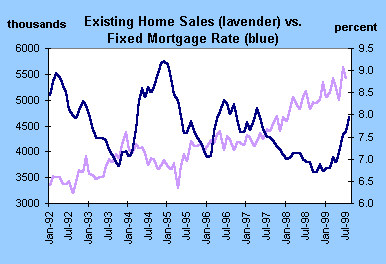 The bottom line on home sales? Consumers tend to buy new furniture and appliances when they move (in a new or previously constructed home). A slowdown in home sales would eventually lead to a moderation in consumer spending on durable goods. Are you invested in housing stocks? In a mature market, one doesn't necessarily need to sell all stocks related to the industry. However, it does make stock picking more important. Some housing-related stocks will perform well even when the market declines, if the company is increasing its market share in the industry.
Real GDP revised down, but still robust underneath it all The sharp deterioration in net exports revealed modest export growth, due to the continued weakness in economies abroad. In contrast, the U.S. demand for imported goods and services is nearly insatiable. The fact that U.S. consumers and businesses could purchase foreign goods helps to hold down inflationary pressures. Demand for goods and services did moderate in the second quarter relative to the previous two periods, but remains healthy. Consumption expenditures grew at better than a 4 ½ percent rate; business fixed investment spending jumped at an 11.2 rate; and residential investment expanded at a 7.7 percent rate. This is not evidence of a marked slowdown in economic activity.  The bottom line on GDP? As long as final sales (GDP less the change in inventories) grows faster than GDP, it portends faster production demand in coming months. The chart above shows that final sales have surpassed GDP growth for three straight quarters. This is not a good sign if you (or the Fed) are expecting slower economic growth.
Greenspan's take on profits At the annual bankers' conference in Jackson Hole, Wyoming, Greenspan talked about new challenges facing monetary policy. He discussed a few issues, but spent a good portion of his time addressing the problem of profit accounting. According to Fed studies, profits were overestimated by 1 to 2 percentage points per year over the past five years. Greenspan felt that this overstatement contributed to the surge in stock prices - and indirectly indicated that it contributed to the bubble in asset prices. 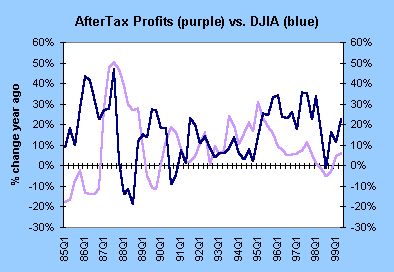 The bottom line on corporate profits? Profits have started to turn around in the past couple of quarters - which would normally bode well for equity prices. Greenspan's insistence that profits are overstated could dampen upward momentum on the market - particularly after the Fed's recent rate hike.
Durable goods pick up steam As indicated in the chart below, new orders are starting to drift higher on a year-over-year basis after some anemic activity late in 1998 and earlier this year. This points to a pickup in industrial production. Yet, it is very important to also monitor closely the unfilled orders series. Unfilled orders are still down from a year ago, although they posted a smaller drop in July than the previous three months. As long as unfilled orders are still declining, it puts a lid on production growth. Incidentally, Greenspan is a big fan of this series, which still gets less attention (than new orders) in the financial markets. 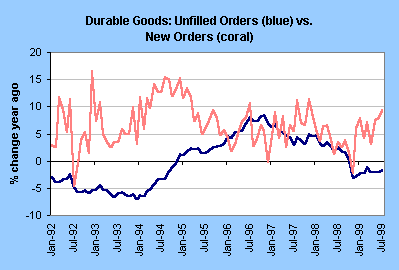 The bottom line on durable goods orders? One month doesn't make a trend, but the chart above does show that new orders are beginning to post some gains on a year-over-year basis after more anemic activity earlier in the year. This could cause some worries among Fed officials about excessive growth, but the manufacturing sector has been the weak link in the robust U.S. economy in the early part of this year. Are you invested in manufacturing stocks? The pick up in new orders suggests that manufacturing activity could improve markedly in the next several months. This could bode well for basic materials and other manufacturing companies - and could be favorable for their stock prices. The advance durables report has a less detailed breakdown than the complete release on factory orders. In any case, primary metals and electronic equipment are posting healthy gains for several months. New orders for industrial machinery and equipment have been less robust in the past three months.
THE BOTTOM LINE The greatest attention was paid to the Fed's directive, which would indicate whether they were keeping a neutral bias, or would go to a tightening bias. The Fed's confirmation of its neutral bias, coupled with the wording of the directive, reassured markets players that this would be the Fed's last tightening action for the year - and hence the market rally on Tuesday. Of course, Greenspan's comments on Friday altered market psychology. We cannot iterate enough, that Federal Reserve officials don't make plans for actions down the road. Yes, the wording on the rate hike announcement sounded like the Fed had completed their rate hike actions, but that only works in the current environment. If economic conditions - and inflationary pressures - were to change by the next FOMC meeting in October, the Fed would raise rates again without hesitation. The latest set of news this week confirms that consumer spending might be in a slower growth period going forward. Yet, the manufacturing sector is showing signs of life. The GDP figures were weaker than last quarter, but final sales are still robust. This kind of news keeps us in limbo with respect to understanding where the Fed is going next. Next week's employment report will gives us a lead on the state of economic conditions for late summer.
Looking Ahead: Week of August 30 to September 3
Monday
Tuesday Economists are predicting The Conference Board's consumer confidence index to edge down in August to 134 from July's level of 135.6. This is a modest drop, and still signals an optimistic consumer.
Wednesday Economists are predicting construction expenditures will rise 1 percent in July, slightly more than the 0.5 percent gain posted in June. This mainly reflects strength in the residential sector; nonresidential structures have been more anemic in recent months. The market consensus calls for a 0.2 percent rise in the index of leading indicators in July. This is only a tad less than the 0.3 percent gains posted in the previous few months. This reflects continued growth in the U.S. economy: no recession on the horizon.
Thursday The market consensus is looking for a downward revision in second quarter nonfarm productivity. The advance estimate showed that nonfarm productivity rose at a 1.3 percent rate, but estimates now indicate a more moderate 1.0 percent gain. Economists expect that unit labor costs will be revised up modestly to a 4 percent rate. Factory payrolls are expected to rise 1.8 percent in July after a 0.7 percent gain in June. This incorporates the 3.3 percent spurt recorded for durable goods for the month and takes into account the surge in defense orders.
Friday |
|||||||||||||||||||||||||||||||||||||||||||||||||||||||||||||||||||||||||||||||||||||||||||